

Big Science in Small Town Japan. Hundreds of particle physicists are descending once more on the sleepy village of Tokai-mura in Eastern Japan.

Over the next week we will discuss the present and future of an experiment that many have devoted several years of their lives to. An experiment that will forge a path into a new era of understanding the creation of our Universe. The Tokai to Kamioka experiment (T2K for short) restarted last month, a year after the massive eastern Japanese earthquake shut it down after just months of operation. The experiment is once again firing an intense beam of neutrino particles 295km through the crust of the Earth from Tokai-mura to the Japanese alps in the West.
In looking at the particles at the start of their journey and again at their final destination we are looking for neutrinos changing their sense of exactly what they are. Neutrinos - Google News. BREAKING NEWS: Error Undoes Faster-Than-Light Neutrino Results. Skip to main content Science/AAAS Subscribe Main menu.

Taiwan Today. Taiwan helps build giant neutrino observatory NTU cosmology professor Chen Pi-sin is on location in Antartica overseeing Taiwan’s work on the international neutrino observatory.
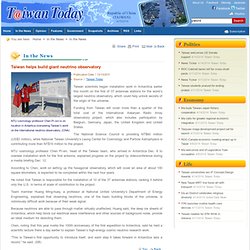
(CNA) Neutrinos and multiverses: a new cosmology beckons - opinion - 28 November 2011. “THE universe is not only queerer than we suppose, but queerer than we can suppose,” as geneticist J.
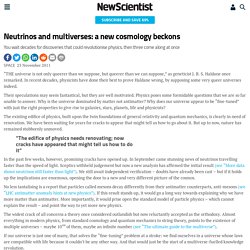
B. S. Haldane once remarked. In recent decades, physicists have done their best to prove Haldane wrong, by supposing some very queer universes indeed. Their speculations may seem fantastical, but they are well motivated. The existing edifice of physics, built upon the twin foundations of general relativity and quantum mechanics, is clearly in need of renovation. “The edifice of physics needs renovating; now cracks have appeared that might tell us how to do it” In the past few weeks, however, promising cracks have opened up.
No less tantalising is a report that particles called mesons decay differently from their antimatter counterparts, anti-mesons (see “LHC antimatter anomaly hints at new physics”). The widest crack of all concerns a theory once considered outlandish but now reluctantly accepted as the orthodoxy. Conclusive evidence may be close at hand. More on these topics: cosmology. How Many Neutrinos Does It Take to Screw Up Einstein? Results from a second experiment uphold the observation that neutrinos are moving faster than the speed of light.
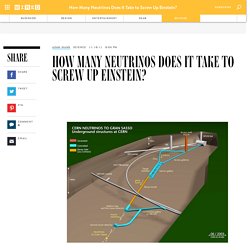
The OPERA collaboration, which first reported the superluminal neutrinos in September, has rerun the experiment and detected 20 new neutrinos breaking Einstein’s theoretical limit. The findings are heartening to anyone hoping to see a major physics revolution in their lifetime. But scientists, as ever, are being cautious, and it will take an independent replication of the results by another team to even begin convincing many of them. “This eliminates one major class of systematic errors, and it’s impressive for the OPERA team to have mounted in a short period of time,” said physicist Robert Plunkett of Fermilab National Laboratory in Batavia, Illinois.
“However, it doesn’t mean that there isn’t an error somewhere else in their system.” Neutrinos are subatomic particles with hardly any mass that are able to fly through most matter as if it weren’t there. A Test for Neutrinos: Put Up or Shut Up : Starts With A Bang. “Where there is no patrol car, there is no speed limit.”
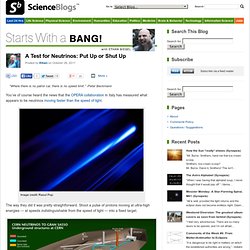
-Peter Beckmann You’ve of course heard the news that the OPERA collaboration in Italy has measured what appears to be neutrinos moving faster than the speed of light. Image credit: Raoul Pop. The way they did it was pretty straightforward. Shoot a pulse of protons moving at ultra-high energies — at speeds indistinguishable from the speed of light — into a fixed target. Image credit: The OPERA collaboration's recent preprint. They’ll produce all sorts of high energy particles: baryons, mesons, electrons, positrons, muons, and more. All the baryons and mesons, all the matter and antimatter, will be blocked by the intervening ground. Image credit: CERN neutrinos to Gran Sasso. Neutrinos not so fast. Neutrinos: faster than the speed of light? By Frank Close To readers of Neutrino, rest assured: there is no need yet for a rewrite based on news that neutrinos might travel faster than light.
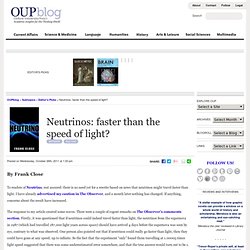
I have already advertised my caution in The Observer, and a month later nothing has changed. If anything, concerns about the result have increased. The response to my article created some waves. There were a couple of cogent remarks on The Observer’s comments section. Neutrino Blog. Not Feeling Very Energetic. As people have pointed out the neutrinos released in supernova deaths of stars, such as SN1987a, a far less energetic than the neutrino beam used by the OPERA experiment.
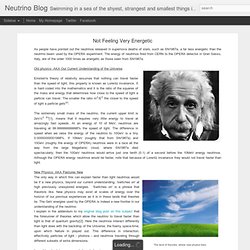
The energy of neutrinos fired from CERN to the OPERA detector in Gran Sasso, Italy, are of the order 1000 times as energetic as those seen from SN1987a. Old physics: AKA Our Current Understanding of the Universe Einstein's theory of relativity assumes that nothing can travel faster than the speed of light, this property is known as Lorentz invariance.
Faster than light - Superluminal neutrinos. This phenomena may have been explained.
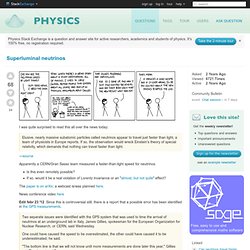
The crux of the problem had to do with differing reference frames - the distance traveled according to the satellites which measured the time was different from the distance traveled according to us on earth. If you're going to measure speed (distance / time), you have to get the distance and time both from the same reference frame. We were getting distance from our reference frame and time from the (very fast) satellite's reference time. This article explains it in a very accessible way: To understand how relativity altered the neutrino experiment, it helps to pretend that we're hanging out on one of those GPS satellites, watching the Earth go by underneath you. The original paper publishing these findings is here: Times of Flight between a Source and a Detector observed from a GPS satelite. Original Post Sources: [1] (Associated Press), [2] (Guardian.co.uk), [3] (Original Publication - Cornell University) Particles found to break speed of light.
Faster than light particles found, claim scientists. Evidence of Faster-Than-Light Neutrinos Puzzles Scientists. Particles break light-speed limit. Quantum Diaries. Sometimes discoveries in science turn up where you are looking for them, like finding treasure near a shipwreck.

At other times they seem to appear from nowhere, as if they’ve fallen from the sky. In particle physics there are plenty of examples of both kinds, but all discoveries have one thing in common. As soon you find something new – whether it’s expected or completely out of the blue – you go back through the analysis with a fine tooth comb, making sure that you’ve missed nothing. Is there a detail you’ve forgotten? Have you overlooked some aspect that could mimic the effect of something new? It’s at this stage that you make your results known to the jury of your peers – other scientists working in the same area who look at what you’ve done and see if they can find anything you might have missed.
This is particularly the case when a result is completely unexpected. Christine Sutton. Particle physicists detect neutrinos travelling faster than light, a feat forbidden by Einstein's theory of special relativity. Neutrino particle traveling faster than light? Two ways it could rewrite physics. Scientists at the European Organization for Nuclear Research (CERN) say they have measured tiny subatomic particles traveling faster than light. Skip to next paragraph Subscribe Today to the Monitor Click Here for your FREE 30 DAYS ofThe Christian Science MonitorWeekly Digital Edition.